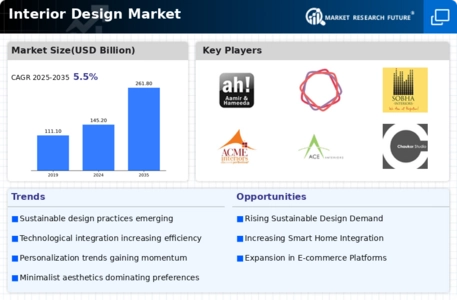Market Trends
Key Emerging Trends in the Interior Design Market
Sustainable and eco-friendly interior design is gaining prominence as consumers prioritize environmentally responsible choices. Designers are incorporating sustainable materials, energy-efficient solutions, and ethical sourcing practices to create interiors that align with eco-conscious lifestyles. Economic conditions impact the interior design market, influencing consumer spending on design services and furnishings. Designers may need to adapt their offerings to cater to varying budget constraints, leading to a diverse range of design solutions in the market. Ongoing innovation in materials and finishes contributes to the evolution of interior design trends. Designers explore novel materials, sustainable options, and innovative finishes to create distinctive interiors. The availability of a wide range of materials influences design choices and aesthetics. The growing prevalence of smart home technologies impacts interior design. Designers incorporate smart home features seamlessly into their designs, considering factors such as integrated home automation systems, smart lighting, and intelligent appliances to enhance the functionality and modernity of spaces. Continuous learning and professional development play a crucial role in the interior design market. Designers need to stay updated on the latest design trends, technologies, and sustainability practices to offer cutting-edge solutions and meet the evolving expectations of clients. The emphasis on health and wellness influences interior design choices. Designers prioritize features that contribute to a healthier living environment, including improved indoor air quality, natural lighting, and ergonomic furniture, aligning with the wellness-focused preferences of consumers. Digital tools and technologies are transforming the interior design process, offering virtual design solutions and augmented reality experiences. Designers and clients alike benefit from 3D modeling, virtual tours, and augmented reality applications that enhance visualization and decision-making during the design phase. Biophilic design, emphasizing a connection to nature, is a growing trend in interior design. Incorporating natural elements, such as indoor plants, natural light, and organic materials, creates spaces that promote well-being and a sense of harmony. The demand for flexible and multifunctional interior spaces is on the rise, driven by changing work patterns and the need for adaptable living environments. Designers are creating versatile spaces that can easily transition between work, leisure, and social activities, catering to the evolving needs of occupants. The rise of e-commerce has extended to the interior design market, with online platforms offering furniture, decor, and design services. Virtual design consultations, online shopping for interior products, and the availability of design inspiration through digital platforms are reshaping the way consumers engage with interior design. Sustainability certifications and standards are becoming important considerations in interior design projects. Designers are increasingly sourcing materials with recognized eco-labels and certifications, ensuring that their designs meet established environmental and ethical standards. Interior designers are engaging in collaborations and partnerships with other industries, including technology, fashion, and art. Cross-industry collaborations bring fresh perspectives and innovative ideas to interior design, resulting in dynamic and trend-setting creations.


 Source: Secondary Research, Primary Research, Market Research Future Database and Analyst Review
Source: Secondary Research, Primary Research, Market Research Future Database and Analyst Review







Leave a Comment